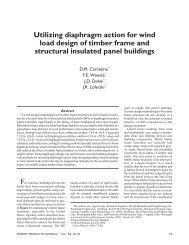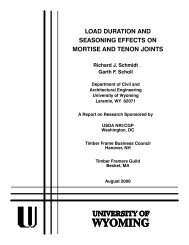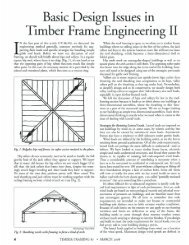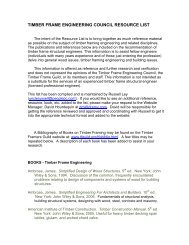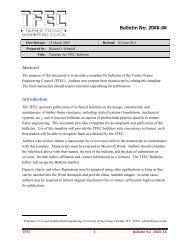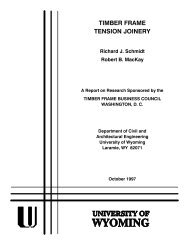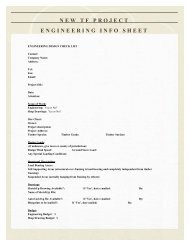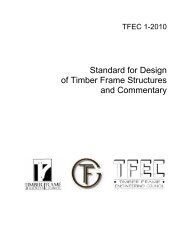Edge Spacing of Pegs in Mortise and Tenon Joints - Timber Frame ...
Edge Spacing of Pegs in Mortise and Tenon Joints - Timber Frame ...
Edge Spacing of Pegs in Mortise and Tenon Joints - Timber Frame ...
Create successful ePaper yourself
Turn your PDF publications into a flip-book with our unique Google optimized e-Paper software.
Introduction<br />
Perpendicular to gra<strong>in</strong> resistance is considered one <strong>of</strong> the weakest mechanical properties <strong>of</strong> wood<br />
due to the possibility <strong>of</strong> splitt<strong>in</strong>g. In most wood frame construction applications, perpendicular<br />
to gra<strong>in</strong> load<strong>in</strong>g is to be avoided. When these types <strong>of</strong> connections are created, the current wood<br />
design criteria <strong>in</strong> the United States imposes spac<strong>in</strong>g restrictions which are meant to limit splitt<strong>in</strong>g<br />
potential. However, most <strong>of</strong> the connections which are detailed <strong>in</strong> the National Design<br />
Specification for Wood Construction (NDS) use metal dowels <strong>in</strong> wood connections (AF&PA<br />
2005).<br />
The use <strong>of</strong> perpendicular to gra<strong>in</strong> connections is common <strong>in</strong> timber frame construction, where<br />
the st<strong>and</strong>ard fastener uses a wood dowel or peg rather than a metal dowel. Many timber frame<br />
jo<strong>in</strong>ts cannot conform to the NDS spac<strong>in</strong>g limitations, <strong>and</strong> previous practice, <strong>in</strong>clud<strong>in</strong>g research<br />
<strong>of</strong> mortise <strong>and</strong> tenon jo<strong>in</strong>ts, found that acceptable jo<strong>in</strong>t strength was achieved at lower spac<strong>in</strong>g<br />
<strong>in</strong>tervals. In fact, Goldste<strong>in</strong> (1999) states that many pegged mortise <strong>and</strong> tenon connections fall<br />
outside <strong>of</strong> the spac<strong>in</strong>g requirements <strong>of</strong> the NDS.<br />
Current NDS <strong>Spac<strong>in</strong>g</strong><br />
Splitt<strong>in</strong>g <strong>of</strong> the mortise member loaded by fasteners perpendicular to gra<strong>in</strong> was one <strong>of</strong> the<br />
identified failure modes from previous timber frame jo<strong>in</strong>t studies, such as Schmidt <strong>and</strong> Daniels<br />
(1999), <strong>and</strong> Miller (2004). The current approach <strong>of</strong> the NDS <strong>in</strong> the United States is to limit<br />
splitt<strong>in</strong>g behavior by restrict<strong>in</strong>g the edge distance <strong>of</strong> fasteners. The loaded edge distance for<br />
dowels loaded perpendicular to gra<strong>in</strong> is 4.0 times the diameter (4D). List<strong>in</strong>g distances as<br />
multiples <strong>of</strong> diameter <strong>of</strong> the bolt provides equivalent scal<strong>in</strong>g. Moss (1997) provides a review <strong>of</strong><br />
the research done to develop the current spac<strong>in</strong>g restriction. Reference to work by Mettem <strong>and</strong><br />
Page (1992) is made for perpendicular to gra<strong>in</strong> load<strong>in</strong>g, but little explanation <strong>of</strong> the choice <strong>of</strong><br />
loaded edge distances is provided.<br />
van der Put Model for Splitt<strong>in</strong>g Perpendicular to Gra<strong>in</strong><br />
The current perpendicular to gra<strong>in</strong> provisions for both the CSA 086 <strong>and</strong> Eurocode 5 are based<br />
upon a fracture mechanics model developed by van der Put (1990) to solve the case <strong>of</strong> notched<br />
beams, which is theoretically similar to the solution <strong>of</strong> a wooden member with a hole loaded<br />
perpendicular to gra<strong>in</strong>. Simplify<strong>in</strong>g assumptions <strong>in</strong>cluded the use <strong>of</strong> superposition, neglect<strong>in</strong>g<br />
normal forces <strong>in</strong> the member, <strong>and</strong> stable crack propagation. Crack propagation was <strong>in</strong>itiated<br />
when the loss <strong>of</strong> potential energy due to crack<strong>in</strong>g was equal to the required energy for crack<br />
formation. An additional requirement was that the fracture energy, G f , associated with crack<br />
propagation, must be <strong>of</strong> sufficient magnitude to propagate the crack <strong>in</strong> both the length <strong>and</strong> width<br />
directions <strong>of</strong> the beam (van der Put <strong>and</strong> Leijten 2000). The relationship for splitt<strong>in</strong>g failure,<br />
derived by van der Put <strong>and</strong> Leijten (2000) <strong>in</strong> Equation 1.<br />
2




